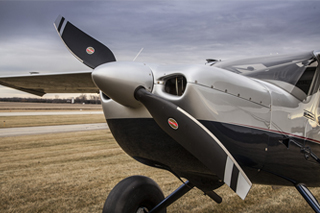
One of the most exciting—and challenging—aspects of building your own aircraft is that you get to customize your project plane exactly how you want it. This includes choosing a propeller for your homebuilt aircraft.
Selecting the right propeller is crucial for flight safety, especially when it comes to experimental and homebuilt aircraft. The prop is one of the most highly stressed components on an airplane, enduring 10 to 25 tons of centrifugal force during normal flight. While homebuilders have a lot of options and flexibility when choosing a prop, it’s important to remember that improper propeller application or modification can lead to serious damage or accidents.
In addition to safety, the right propeller can enhance the performance of your homebuilt airplane significantly. Today’s advanced propellers offer performance traits to fit any mission, whether you’re looking for STOL or aerobatic capabilities, increased cruise speed, or simply smoother, quieter operation. The propeller is also one of the most visible components on your airplane. You’ll want a prop that not only meets your performance goals but also looks great!
As you get ready to choose a propeller for your homebuilt aircraft, here are some factors to keep in mind:
One way to narrow down your propeller decision is to choose the engine first. Based on your goals for performance and power, you may already have an engine type in mind. If you’re building a less-common aircraft design with a certified aircraft engine (i.e., Lycoming or Continental), the best approach is usually to copy the firewall forward off a certified, factory-built aircraft. Using an approved engine/propeller/governor combination from a factory-built aircraft takes much of the guesswork out of your powerplant installation.
If you’re using a kit, refer to the kit manufacturer’s recommendations. Most popular kit manufacturers have carefully researched and tested the engine/propeller combinations that work best with their designs.
A note on non-aircraft engines: We’re sometimes asked about propellers to pair with non-aircraft engines, mainly converted automobile engines. It’s important to consider that aircraft engine manufacturers put years of extensive research, development, and testing into ensuring their designs are highly reliable. To put it simply, aircraft engines are designed specifically for the demands of flight; auto engines are not. At Hartzell, we do not endorse the use of Hartzell propellers on converted automobile engines unless vibration testing has been performed.
To quote our friends at Van’s Aircraft: “No non-aircraft engine has yet been proven to be as reliable, maintainable, available, and inexpensive (all things considered) as a traditional aircraft engine.”
In the past, simple fixed-pitch wood propellers were common on homebuilt planes. But as aircraft designs have advanced, homebuilders are gravitating toward more sophisticated propeller options. Most blades today are made from aluminum or carbon-fiber composite materials.
Aluminum blades are heavier than wooden props but are far more durable and reliable. Composite propellers are the latest in propeller technology, offering excellent performance, significant weight-savings, and longer service life. Durable, lightweight composite blades are especially valuable for airplanes flown for aerobatics and backcountry operations.
An experimental airplane doesn’t necessarily need an experimental propeller. In fact, using a non-certified aircraft propeller can cause major headaches for homebuilders. If you choose to install a non-certified prop, you can expect to expand the FAA Phase I flight testing period from 25 hours to 40 hours, even if the engine is certified. This can be a big drawback if you’re looking to complete your project in a timely manner.
Certified aircraft propellers have been carefully designed and tested to meet rigorous standards for strength and endurance against fatigue problems. Overall, certified props offer less risk when used with an approved engine combination.
If you’re trying to make your homebuilt project more affordable, you may have considered purchasing used parts and materials. But when it comes to used propellers, be cautious. Looks can be deceiving, and a pre-owned prop that appears to be in good shape could have internal damage that’s beyond repair limits. It’s best to take the used propeller to an approved prop shop and let the experts determine if the propeller is safe to install.
Hartzell Propeller offers a wide variety of aircraft propellers for the experimental and homebuilt community. We work with the world’s top kit manufacturers to develop advanced propellers compatible with their recommended engine for the kit. If you’re building one of these popular kits, you may even be able to buy a new Hartzell propeller directly from the kit manufacturer.
Read our frequently-asked kitplane questions and contact our team for more information about finding the right Hartzell prop for your homebuilt project.